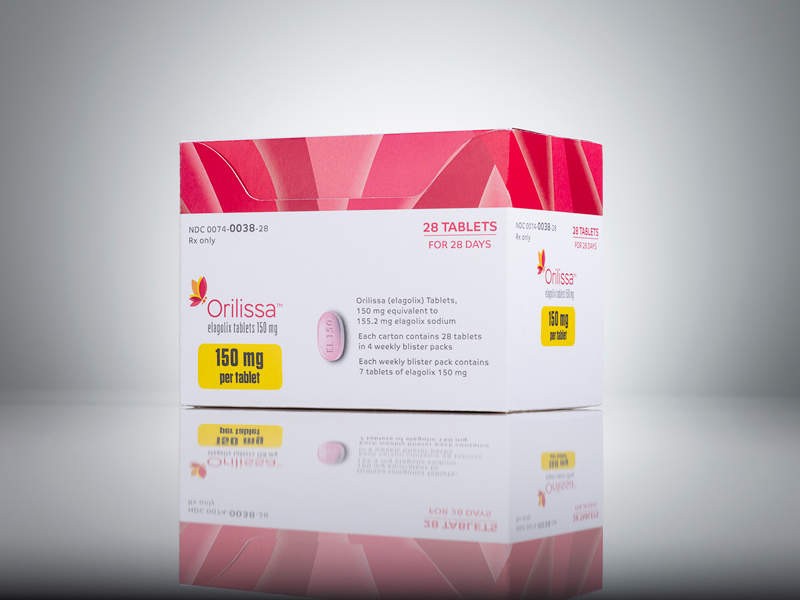
Contents
Orilissa (elagolix)
Orilissa is a prescription medicine used to treat moderate to severe pain associated with endometriosis. It is not known if Orilissa is safe and effective in children under 18 years of age.
What are the side effects of Orilissa?
Orilissa may cause serious side effects, including:
- bone loss (decreased bone mineral density).
- While taking Orilissa, your estrogen levels will be low, which can lead to bone mineral density loss.
- Your bone density may improve after stopping Orilissa, but complete recovery may not occur. It is unknown if these bone changes could increase your risk for broken bones as you age.
- Your healthcare provider may advise you to take vitamin D and calcium supplements to promote bone health.
- If you have conditions or take other medicines that can cause bone loss, or if you have broken a bone with minimal or no injury, your healthcare provider may order an X-ray test called a DXA scan to check your bone mineral density.
Orilissa can cause serious side effects including:
- suicidal thoughts, suicidal behavior, and worsening of mood. Orilissa may cause suicidal thoughts or actions. Call your healthcare provider right away if you have any of these symptoms or call 911 if an emergency, especially if they are new, worse, or bother you:
- thoughts about suicide or dying
- try to commit suicide
- new or worse depression
- new or worse anxiety
- other unusual changes in behavior or mood
You or your caregiver should pay attention to any changes, especially sudden changes in your mood, behaviors, thoughts, or feelings.
- abnormal liver tests. Call your healthcare provider right away if you have any of these signs and symptoms of liver problems:
- yellowing of the skin or the whites of the eyes (jaundice)
- dark amber-colored urine
- feeling tired (fatigue or exhaustion)
- nausea and vomiting
- generalized swelling
- right upper stomach area (abdomen) pain
- bruising easily
The most common side effects of Orilissa include: hot flashes or night sweats, headache, nausea, difficulty sleeping, absence of periods, anxiety, joint pain, depression and mood changes.
These are not all the possible side effects of Orilissa. Call your healthcare provider for medical advice about side effects.
You may report side effects to FDA at 1-800-FDA-1088.
What is the dosage of Orilissa?
- Take Orilissa as directed by your healthcare provider.
- Your healthcare provider will give you a pregnancy test before starting Orilissa or within 7 days after starting your period.
- If your healthcare provider prescribes: Orilissa 150 mg (a pink tablet), take it once daily.
- If your healthcare provider prescribes: Orilissa 200 mg (an orange tablet), take it twice daily.
- 150 mg (once daily), take it as soon as you remember on the same day. Do not take more than 1 tablet each day.
- 200 mg (twice daily), take it as soon as you remember on the same day. Do not take more than 2 tablets each day.
- If you take too much Orilissa, call your healthcare provider or go to the nearest hospital.
QUESTION
What drugs interact with Orilissa?
Elagolix is a weak to moderate inducer of cytochrome P450 (CYP) 3A. Co-administration with Orilissa may decrease plasma concentrations of drugs that are substrates of CYP3A.
Elagolix is a weak inhibitor of CYP 2C19. Co-administration with Orilissa may increase plasma concentrations of drugs that are substrates of CYP2C19 (e.g., omeprazole).
Elagolix is an inhibitor of efflux transporter P-glycoprotein (P-gp). Co-administration with Orilissa may increase plasma concentrations of drugs that are substrates of P-gp (e.g., digoxin).
Potential For Other Drugs To Affect Orilissa
Elagolix is a substrate of CYP3A, P-gp, and OATP1B1.
Concomitant use of Orilissa 200 mg twice daily and strong CYP3A inhibitors for more than 1 month is not recommended. Limit concomitant use of Orilissa 150 mg once daily and strong CYP3A inhibitors to 6 months.
Co-administration of Orilissa with drugs that induce CYP3A may decrease elagolix plasma concentrations.
The effect of concomitant use of P-gp inhibitors or inducers on the pharmacokinetics of Orilissa is unknown. Co-administration of Orilissa with drugs that inhibit OATP1B1 may increase elagolix plasma concentrations. Concomitant use of Orilissa and strong OATP1B1 inhibitors (e.g., cyclosporine and gemfibrozil) is contraindicated.
Drug Interactions-Examples And Clinical Management
Table 7 summarizes the effect of co-administration of Orilissa on concentrations of concomitant drugs and the effect of concomitant drugs on Orilissa.
Table 7. Established Drug Interactions Based on Drug Interaction Trials
| Concomitant Drug Class: Drug Name |
Effect on Plasma Exposure of Elagolix or Concomitant Drug | Clinical Recommendations |
| Antiarrhythmics digoxin |
↑ digoxin | Clinical monitoring is recommended for digoxin when co-administered with Orilissa. |
| Antimycobacterial rifampin |
↑ elagolix | Concomitant use of Orilissa 200 mg twice daily and rifampin is not recommended. Limit concomitant use of Orilissa 150 mg once daily and rifampin to 6 months. |
| Benzodiazepines oral midazolam |
↓ midazolam | Consider increasing the dose of midazolam and individualize therapy based on the patient’s response. |
| Statins rosuvastatin |
↓ rosuvastatin | Consider increasing the dose of rosuvastatin. |
| Proton pump inhibitors omeprazole |
↑ omeprazole | No dose adjustments are needed for omeprazole at doses of 40 mg once daily or lower. When Orilissa is used concomitantly with higher doses of omeprazole, e.g. in patients with Zollinger-Ellison syndrome, consider dosage reduction of omeprazole. |
| The direction of the arrow indicates the direction of the change in the area under the curve (AUC) (↑= increase, ↓ = decrease). | ||
Is Orilissa safe to take while pregnant or breastfeeding?
Do not take Orilissa if you are trying to become or are pregnant. It may increase the risk of early pregnancy loss. If you think you are pregnant, stop taking Orilissa right away and call your healthcare provider.
If you become pregnant while taking Orilissa, you are encouraged to enroll in the Pregnancy Registry. The purpose of the pregnancy registry is to collect information about the health of you and your baby. Talk to your healthcare provider or call 1-833-782-7241to enroll in this registry.
Orilissa may change your menstrual periods (irregular bleeding or spotting, a decrease in menstrual bleeding, or no bleeding at all), making it hard to know if you are pregnant. Watch for other signs of pregnancy such as breast tenderness, weight gain, and nausea.
Orilissa does not prevent pregnancy. You will need to use effective methods of birth control that do not contain hormones such as condoms or spermicide while taking Orilissa and for 1 week after you stop taking Orilissa. Birth control pills that contain estrogen may make Orilissa less effective. It is not known how well Orilissa will work while you are taking progestin-only birth control such as injections or implants.
Talk to your healthcare provider about which birth control to use during treatment with Orilissa. Your healthcare provider may change the birth control you were on before you start taking Orilissa.
Do not take Orilissa if you are breastfeeding or plan to breastfeed. It is not known if Orilissa passes into your breastmilk. Talk to your healthcare provider about the best way to feed your baby if you take Orilissa.
Summary
Orilissa (elagolix) is a prescription medicine used to treat moderate to severe pain associated with endometriosis. Bone density loss can be a serious side effect.


